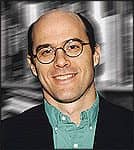
|
I fear that I’ve finally passed the threshold test for being “a grumpy old guy.” For example, upon seeing a young person’s tattoo, I never think this might be his/her statement as an individual or even “Gee, that’s a cool tattoo.” Instead, I think, “Mercy, they’re going to have a hard time finding a good job unless they get that thing removed.” Similarly, when I hear a car stereo playing at ear-shattering decibel levels, I think, “You’re going to kill your hearing!” ignoring the fact that I did the same thing (albeit with technologically damped 8-tracks and cassettes). I dread that all of this foreshadows the fact that I’m one pathetic step away from yelling at the neighbor kids to get off my lawn.
So, this admission aside, I can’t stop thinking about how—between cell phones and MP3 players—today’s young people are going to have any hearing left by the time they reach my grumpy old age of 46. Look, I admit it: as a teenager, I put my head right up to the stereo receiver to figure out what Mick Jagger was yelling in the opening of “Get Off of My Cloud” (I lived in an apartment on the 99th floor of my block), and I can’t see how that’s much different acoustically than having an iPod turned up to 90 to 100% volume. However, there are at least two components to noise-induced hearing loss (NIHL): loudness level and duration. Generally, I could only listen to loud music in a car or in my room for limited time periods—roughly defined by the amount of time it took for my saintly mother to yell “Turn it down!” for the third time. In the 70s and 80s, each of the receivers of my “personal listening device” was about the size and weight of an office copier/fax machine, and my stereo turntable and 80-pound stack of records were exactly as portable as the cord was long.
There’s also another big difference between then and now relative to NIHL. When today’s younger folks aren’t listening to their iPods or car stereos, they’re listening to friends on cell phones at decibel levels in which I can clearly hear both sides of the conversation while standing nearly six feet away—over traffic. Cell phones are practically a rite of passage for today’s teens; my teenage conception of a high-tech portable phone was the one Maxwell Smart had on the bottom of his shoe (rotary no less!).
None of the above, by the way, is a knock against today’s Gen X’ers or Y’ers. Given the technology, I’m sure that I would have listened to The Stones at full volume on my iPod while walking down the street, riding the bus, and working at my mind-numbing hard-labor jobs; given the opportunity, I almost certainly would have talked incessantly with friends at high volumes due to the temporary threshold shift my iPod gave me. So, this grumpy old guy is not criticizing these folks for taking advantage of the technological wonders of their age. I’m jealous, not critical. And I’m only pointing out what should seem obvious: we may be facing an epidemic of hearing loss.
Indeed, last year, a research team at Johns Hopkins University estimated that 55 million Americans have hearing loss in one or both ears, with men, whites, and the least-educated most affected (see the April 9, 2009 HR The Insider). The report, which appeared in JAMA’s Archives of Internal Medicine, showed that 16.1% of US adults (29 million) had hearing loss in the speech frequencies. In the youngest age group tested (20 to 29 years), 8.5% exhibited hearing loss, and prevalence appears to be growing in this demographic. Granted, the definition of “hearing loss” was 25 dBHL, but I think the report remains alarming (also see Brian Fligor’s article “Portable Music and Its Risk to Hearing Health” in the March 2006 HR).
Mercy, they’re going to have a hard time finding a good job if they can’t hear. Which brings me circuitously to the Hearing Aid Tax Credit bill, the topic of this month’s special HR supplement produced by Alan Ruskin with the assistance of Will Campbell. A new US Senate version of the bill expanded the qualifications so that people of all ages could receive a tax deduction of $500 per hearing aid every 5 years. Previously, the bill was limited to those ages 55+ or to parents of dependent children. If approved, this may end up being a huge factor in the lives of an entire generation. HR’s October 2005 edition carried a feature story entitled “Hearing Loss and Its Impact on Household Income” that shows untreated hearing loss can negatively affect income by up to $12,000 per year, and the cost of untreated hearing loss may be in the range of $100 billion annually. In this month’s supplement, the HIA’s Andy Bopp says that the Hearing Aid Tax Credit has been scored by the government to cost $300 million annually, or $3 billion over 10 years. In light of the above information, this grumpy old guy thinks this sounds like a pretty good investment.
Karl Strom
Editor-In-Chief





